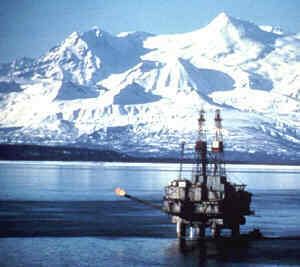
Secretary of the Interior Dirk Kempthorne today announced a major federal initiative to boost oil and natural gas production on the U.S. Outer Continental Shelf in the Gulf of Mexico and off Alaska. The program could produce 10 billion barrels of oil and 45 trillion cubic feet of natural gas over 40 years, generating almost $170 billion, in today’s dollars, in net benefits for the Nation.
“The Outer Continental Shelf is a vital source of domestic oil and natural gas for America, especially in light of sharply rising energy prices and increasing demand for these resources,” Kempthorne said. “This energy production will create jobs, provide greater economic and energy security for America and can be accomplished in a safe and environmentally sound manner.”
Interior’s Minerals Management Service developed the initiative, known as the Five Year Outer Continental Shelf Oil and Gas Leasing Program, to guide domestic energy leasing on the OCS from 2007 to 2012. The program proposes 21 lease sales in 8 planning areas. Twelve sales are slated for the Gulf of Mexico, 8 off of Alaska and, at the request of the Commonwealth of Virginia, one in the Mid-Atlantic Planning Area, about 50 miles off the coast of southern Virginia.

. . .
Kempthorne emphasized that the proposal balances the critical need for domestic energy resources with the equally critical need to protect human, marine and coastal environments. He noted the program was developed through extensive consultation, public comment and the rigorous analysis required by the Outer Continental Shelf Lands Act and the National Environmental Policy Act.
“We consulted extensively with Members of Congress, state, local and tribal officials, industry, environmental organizations and received comment from more than a hundred thousand interested citizens,” Kempthorne said. “This program gives great weight to the desires of coastal states regarding oil and gas development near their shores and environmentally sensitive areas were removed from proposed lease sales.”
He also noted that 75 percent of the comments received from the public supported some level of increased access to the domestic energy resources of the Outer Continental Shelf. (yes...the "public"...not energy companies)
There is no leasing proposed within 125 miles of the Florida coast or east of the military mission line in the Eastern Gulf. The program includes a Central Gulf sale in 2007 that involves a portion of the Sale 181 area and, as mandated by the Gulf of Mexico Energy Security Act of 2006, one lease sale in the Eastern Gulf in 2008.
The Act, signed by President George W. Bush on December 20, 2006, requires oil and gas leasing in a portion of the area known as the “Sale 181 Area,” consisting of 2,574,823 million acres, of which 2,028,730 is in the Central Gulf and about 546,093 acres is in the Eastern Gulf of Mexico Planning Area. The proposed sale area “181 South” consists of 5,762,620 acres. The total of new areas in the Gulf offered under the proposed program is 8,337,443 acres.
The leasing program schedules eight sales in Alaska: two in the Beaufort Sea; three in the Chukchi Sea; up to two in Cook Inlet; and one in the North Aleutian Basin – in an area of about 5.6 million acres that was previously offered during Lease Sale 92 in 1985. There are currently no existing leases in the North Aleutian Basin. These areas would be subject to environmental reviews, including public comment, and extensive consultation with state and local governments and tribal organizations before any lease sale proceeds.
The program also includes a proposed sale in the Mid-Atlantic Planning Area off the coastline of Virginia in late 2011. Between the current presidential withdrawal and the annual congressional moratoria, the majority of the OCS around the lower 48 states is off limits to energy development, including all areas off Virginia. This sale would, therefore, only take place if the presidential withdrawal is modified and the congressional moratorium discontinued in the Mid-Atlantic Planning Area.
This planning area excludes a 50-mile coastal buffer from leasing consideration as requested by the Commonwealth of Virginia, as well as a wedge-shaped No-Obstruction Zone to avoid conflicts with navigation activities in and out of the Chesapeake Bay.
No lease sale would proceed without additional and more site-specific analysis of its environmental effects under the National Environmental Policy Act.
A Notice of Availability for the 5-Year program and its Final Environmental Impact Statement will appear in the Federal Register on May 2, 2007. As required by the OCS Lands Act, the program was submitted to the President and Congress today and, after 60 days, the Secretary may approve it to take effect on July 1, 2007. The complete proposed program is online at http://www.mms.gov/5-year/.
there it is
also, if you have kids you should definitely check out MMS's Kid's Corner. the little ones will be fascinated by their description of offshore oil and gas platforms! or not.








